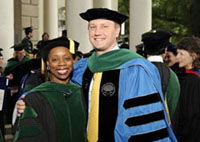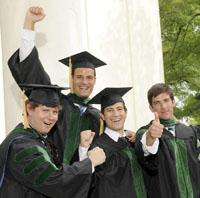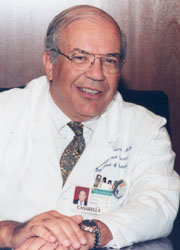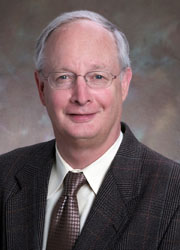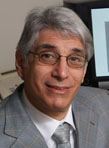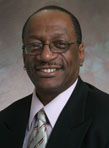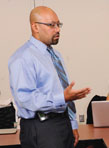 |
|||||||||||||||||||
June 2012 |
|||||||||||||||||||
The globalization of residency trainingNot too long ago, Grady, the VAMC, Children's Healthcare, and Emory's hospitals and clinics provided almost all the real world experiences a resident might need to become a knowledgeable practicing physician or researcher. Now Emory residents have a new opportunity. They can experience health care in a resource-constrained setting through one-month rotations in Ethiopia with the Global Health Residency Scholars Program (GHRSP), established last year with funding from the medical school's new Global Health Strategic Initiative. For the past five years, the Department of Medicine has funded similar rotations for six or seven third-year internal medicine residents, most of whom completed one-month clinical rotations at Black Lion Hospital, a large public hospital affiliated with Addis Ababa University (AAU). Dominique Cosco, who was one of the first medicine residents to go to Ethiopia in 2007, now directs the department's Global Health Distinctions Program, which helps residents prepare for their experience. The medical school's new funding will allow other areas to send residents in the upcoming academic year, including the departments of surgery, radiology, pediatrics, dermatology, anesthesiology, pathology, gynecology and obstetrics, family and preventive medicine, and rehabilitation medicine. All the residents, except for surgery's, will train at AAU. Surgical residents will train at Soddo Christian Hospital, about 240 miles south of Addis Ababa. "GHRSP's goal is to build a global platform for Emory and develop collaborations among departments that are involved at AAU," says Carlos del Rio, who co-directs the program with Henry Blumberg. The one-year curriculum for residents includes monthly didactic sessions, lectures, and seminars in Atlanta, as well as a journal club.
James Lee, a third-year resident with plans to start a cardiac imaging fellowship in August, spent the month of March in Addis Ababa. "It was a unique opportunity to see a medical system that's different than what we have here," he says. "While we had some preparation for what we might see, it was very different from what I expected." He notes that patient care there emphasized the physical exam more than lab work and films. "About 50% of the cardiac patients I saw were young—in their 20s and 30s—and dying of heart failure due to untreated rheumatic heart disease they had as children," he says. "Although the facilities there are modernizing, resources are limited, and very few people are able to receive prosthetic valves or heart catheterizations. We had to do what we could with the medications that were available. We saw many cases that could have had positive outcomes if we had seen them here in the United States." Lee says that the experience was frustrating at times but extremely rewarding. A highlight for him was teaching third-year AAU medical students how to take a patient history, perform a physical exam, and develop a diagnostic plan. Third-year resident Lindsay Margoles, who will start an infectious disease fellowship at Emory in July, also traveled to Ethiopia in March. "I found that many of the tetanus patients there were in the ICU and had been intubated a long time, something that you wouldn't see here in the United States. I also started gathering data for my own study on tuberculosis. During our last week, we provided bedside teaching and led differential diagnosis mini-conferences." In addition, Margoles developed a proposed template for Emory residents to provide guidelines on global rotations in Addis Ababa. Other residents chosen to go to Ethiopia this year include Melissa Rader (anesthesiology), Josette McMichael (dermatology), Alisa Kachikis and Abdulrahman Sinno (gyn/ob), Julia Rosebush (pediatrics/infectious disease), Wilawan Nopkhun (physical medicine/rehab), Jordan Kempker (pulmonology/allergy/critical care), Annie Gill, Andrew Lemmon, and Ryan Peterson (radiology), and Sandeep Krishnan, Jeremy Chow, Tiffany Walker, Valeria Cantos, Meghan Lyman, Jia Shen, and Rachel Anquez (internal medicine).
Graduation 2012Every May, the School of Medicine sends another batch of our finest students off into the world to complete their training. I hope all the faculty feel a sense of pride, knowing that they have contributed to the crafting of another good doctor. This year’s graduation was especially poignant for me. It was my last as dean, and I also hooded my daughter Meg and son-in-law David. Bill Eley, executive associate dean for medical education, was our graduation speaker. Interestingly, he told this year's graduating class that he did not want them to become anything like the faculty they had trained under for the past four years. "Our goal is not that you become physicians like us; we want you to surpass us. If you got into medical school you must be really, really smart. But that's not why we admitted you. We admitted you because we thought you had compassion." One doctor the class of 2012 would like to emulate is Kimberly Manning, an internist at Grady Hospital and recipient of this year’s Evangeline Papageorge Award. One student, of many who nominated her, said, "She reminds me why I choose medicine." The class also inducted Charles Sewell (pathology) as an honorary member. Thank you to all of our faculty and staff and volunteers who help make this day memorable for our graduates and families.
Behind the scenes at the School of MedicineIn the second article about the administrators who work in the dean's office, we talk to two executive associate deans, Bill Casarella, who heads up clinical affairs at Grady, and Ray Dingledine, who leads SOM research. Both have served as chair—Casarella as chair of radiology from 1981 to 2004 and Dingledine as the current chair of pharmacology since 1992. And both are experienced and skilled at running SOM operations from the clinical and research fronts.
"Dean Richard Krause asked me to coordinate SOM activities at Grady in 1987," says Casarella. "From that time on, I became personally involved with Grady, and the past 25 years have been an interesting ride." He is quick to give Dean Lawley credit for a strong Emory presence at Grady. His primary duties include dealing with faculty issues, structuring clinical departments, analyzing financial reports, and overseeing the Emory Medical Care Foundation (EMCF), a group practice that provided $34.9 million in financial support to Grady in fiscal year 2011. One of the most important things he's working on now is renewing a 30-year Emory/Grady contract that's set to expire next year. Some of the key components of the new contract include finding better ways to conduct clinical operations more efficiently and stabilizing Grady’s budget with Emory. It has provisions to involve faculty more in hospital decisions as well as develop them so they feel a career there is a rewarding choice, says Casarella. Most important, it emphasizes high quality, patient-centered care. "Providing patient-centered care in a downtown hospital that treats primarily indigent patients is very doable," remarks Casarella. "I'm very optimistic about our future and am very glad that John Haupert [appointed as Grady CEO in Oct. 2011] is on board with the new contract. He's a major plus. For the first time in recent memory, Grady is in the black, for the first quarter of 2012." The Emory administrative team that works alongside Casarella on clinical affairs—better known as the "Grady Bunch"— include Constance Nagle (assistant dean for business and finance), who is in charge of a $117 million budget, including collections from EMCF and contributions from SOM and Grady. Working with her are Judy Fernandez (associate director of finance) and Ivan Warner (financial analyst in charge of billing). Meredith O'Keefe (EMCF executive administrator) has led efforts to develop individual service agreements between each clinical department and Grady, a unique concept among academic medical centers. The agreements will spell out what clinical services faculty will provide to patients and the financial contributions Grady will in turn provide to the department. Other EMCF administrators include Angela Gardner (chief operating officer) who directs business operations, Raf Gershon (medical director) who leads clinical services, and Bill Sexson (associate dean for clinical services) who is in charge of facilities, daily operations, and the more than 700 Emory faculty at Grady who make up the full-time equivalent of nearly 300 physicians. Sid Stein (associate professor of hematology/oncology and an attorney) has helped build the EMCF since it was established in 1980. While Casarella is deeply attuned to Grady, he enjoys spending time with his family, which includes 10 grandchildren and five children. He is a former golfer and runner on hiatus after having two operations earlier this year. His wife of 20 years is Kay Vydareny, professor of radiology emeritus, who is an associate executive director for American Board of Radiology and a master's level triathlete.
While Casarella focuses mainly on clinical care, Ray Dingledine has been Emory's go-to guy for research since 2008. He is responsible for creation and oversight of SOM research strategic plans, post-doctoral education, core research labs, research information technology services, and the division of animal resources, our largest core facility. "One of the day-to-day things I do is manage the best use of research space," he notes. "Most of this space, 75% in fact, is contained in seven buildings on the Clifton campus, and the rest is in 29 buildings scattered throughout metropolitan Atlanta." Dingledine has helped institute a "new point of view" for monitoring research. "We are making a process shift in culture and are changing how we gauge success," he says. "It has been traumatic, I have to admit. In the past, research was judged solely by financial metrics, based on the amount of NIH funding we received and the percentage of market share we had. We are now ranked 15th among U.S. schools of medicine funded by the NIH, and this is a tremendous shift from the 1990s, when we were in the low 40s. Now that 2% of all NIH extramural funds go to Emory, we need to shift our attention to our actual accomplishments rather than rely on the financial surrogate." Dingledine has helped set up programs that identify and recognize faculty achievement. The first, the MilliPub Club, recognizes faculty whose research has generated more than 1,000 citations of one or more papers. The second is Game Changers, featuring faculty whose research has made a great advance in medicine. "I am very pleased that investigators are showing enthusiasm for these programs," he remarks, "and are saying 'I've heard of Game Changers. I didn't know the impact Emory was making worldwide!'" Dingledine and his team are looking over the next one to two years to consolidate scientifically related research cores to share a common administration and find new ways to better integrate the SOM's three-fold mission. "It's a worthy goal. For example, the first combined Emory Healthcare/SOM core is the Emory Personalized Immunotherapy Center, a new cell therapy facility that will conduct first-in-human clinical studies of new therapies," he says. To meet an uncertain future, Dingledine expects the SOM will have to apply for research funding creatively, including taking advantage of the latest federal research emphases on funding health services research and drug discovery and partnering more with Emory Healthcare on research focusing on health care quality, health services, and clinical care. “In my opinion the single best opportunity and challenge we have is to strengthen our partnership with Emory Healthcare,” he says. The people who work most closely with Dingledine include Carolyn Meltzer (associate dean for research), who is involved in almost all major decisions in research administration, and Jeff Lennox (associate dean for clinical research), who is responsible for improving clinical research. Fadlo Khuri (associate dean for translational research) is helping replicate the Winship phase 1 clinical trials unit into other domains, and Mary DeLong (assistant dean for post-doctoral education) is creating such popular lab start-up programs that her last workshop was full within 15 minutes after going up on the web. Mike Huerkamp (director, division of animal resources) is in charge of Emory's veterinary staff and all animal research facilities, Mark Overcash oversees research IT services and Trish Haugaard, "who knows the SOM's inner workings as well as anybody and can juggle 100 balls at once," is the assistant dean for research administration. What you may not know is that Dingledine's hobbies include swimming and the ancient art of growing bonsai trees—he's been doing it since 1971 and has about 20 trees growing, a few of which are more than 50 years old. He periodically competes with a few friends in the Tugaloo Triathlon at Tugaloo State Park in the relay division, which they've won three times. He swims the 1.5-kilometer leg of the course in Lake Hartwell and finished a 47K bike ride and 10K run.
Spotlight on Microbiology and ImmunologyFor the past three years since Jeremy Boss was named chair of the Department of Microbiology and Immunology, the department has continued to excel in terms of research funding and national prestige. With $22 million in funding, it is a top-five department in the country in NIH research awards. Boss himself is also the editor-in-chief of the Journal of Immunology, one of the most cited publications in biomedicine. "In accordance with the missions of the school, the department's strategic plan is to increase and sustain research programs that are focused on understanding the molecular and cellular bases for infectious disease and the immune processes that protect us from infection," says Boss. "Faculty members within the department have pursued these goals by establishing important relationships within Emory and throughout the world." The department's 19 faculty members teach all medical students, as well as a variety of courses in the Graduate Division of Biological and Biomedical Sciences, including programs in genetics and molecular biology, immunology and molecular pathogenesis, and microbiology and molecular genetics. Over the years the faculty have served as leaders of these graduate training programs, and they also collaborate with a number of other Emory departments, entities, and affiliate organizations, including the Emory Vaccine Center, Hope Clinic, Yerkes, American Cancer Society, Georgia Tech, CDC, and others. Major activities and accomplishments over the past year include the following:
Recent awards and honors
Wendy Armstrong (infectious disease) received the 2012 Emory University Hospital Teaching Award. Allen Dollar (cardiology) received the 2012 Grady Hospital Golden Apple Teaching Award. Doug Eaton (physiology) received the 2012 Robert Berliner Award from the American Physiological Society's Renal Section. Mark Goodman (radiology) received the 2012 Paul Aebersold Award for achievements in basic sciences applied to nuclear medicine. Nadine Kaslow (psychiatry) received an honorary Doctor of Humane Letters from Pepperdine University. Patrick Kelly (infectious disease) received an Outstanding Service Award from Prideindex.com, a Chicago-based news and entertainment website, which recognizes individuals and organizations in Chicago and nationally for contributions to the black and LGBT communities. Kelly is a clinical research interviewer at the Hope Clinic. Noble Maleque (hospital medicine) was appointed associate program director of the Department of Medicine's residency program at EUH Midtown. The following members of the Class of 2013 were inducted into the Alpha Omega Alpha Honor Medical Society: Joel Chasan, Jonathan de Olano, Eve Lake, Megan McCullough, Stefanie Reiff, Joelle Rosser, Allison Rose, Robert Runner, Christopher Smitson, Kevin Sullivan, and Lydia Wright. | |||||||||||||||||||
 |
|||||||||||||||||||



